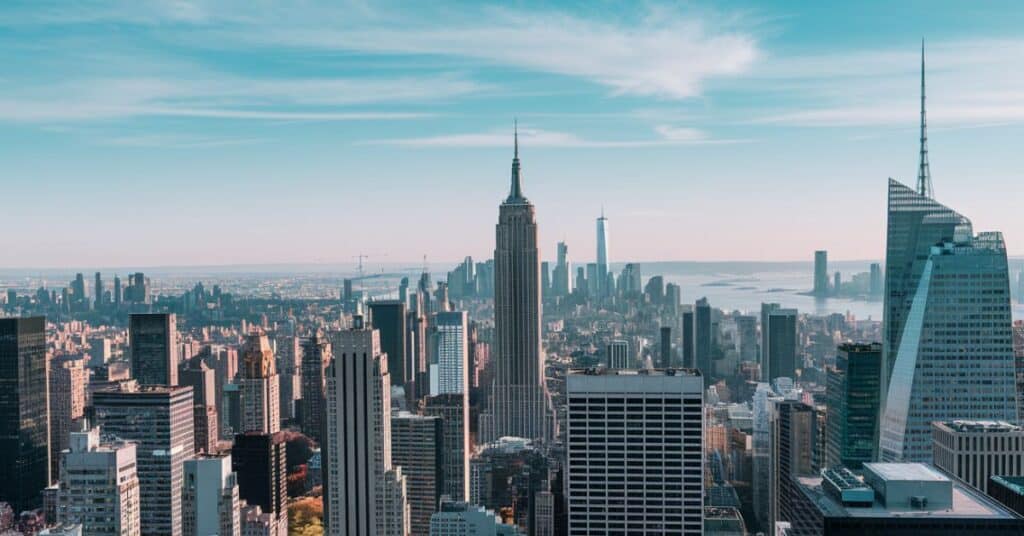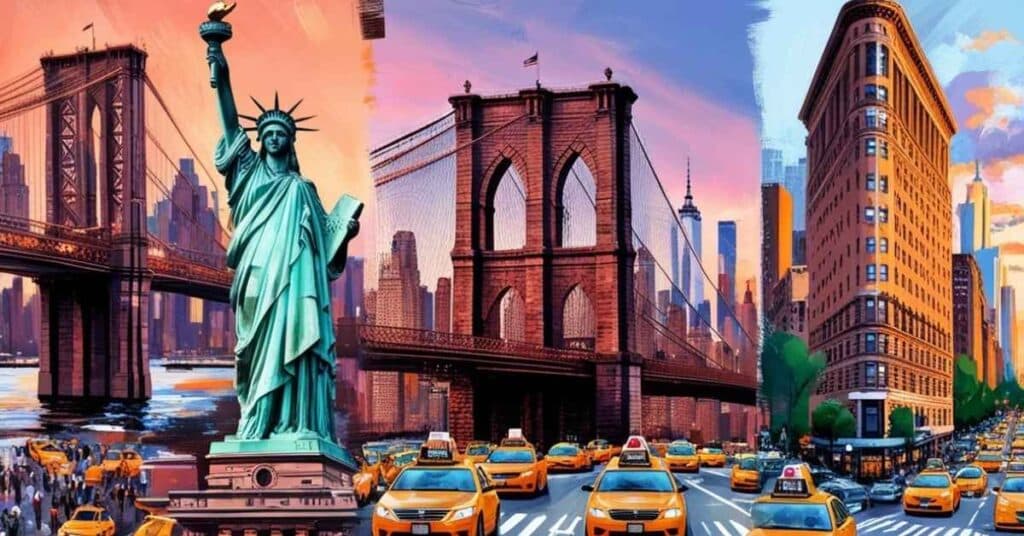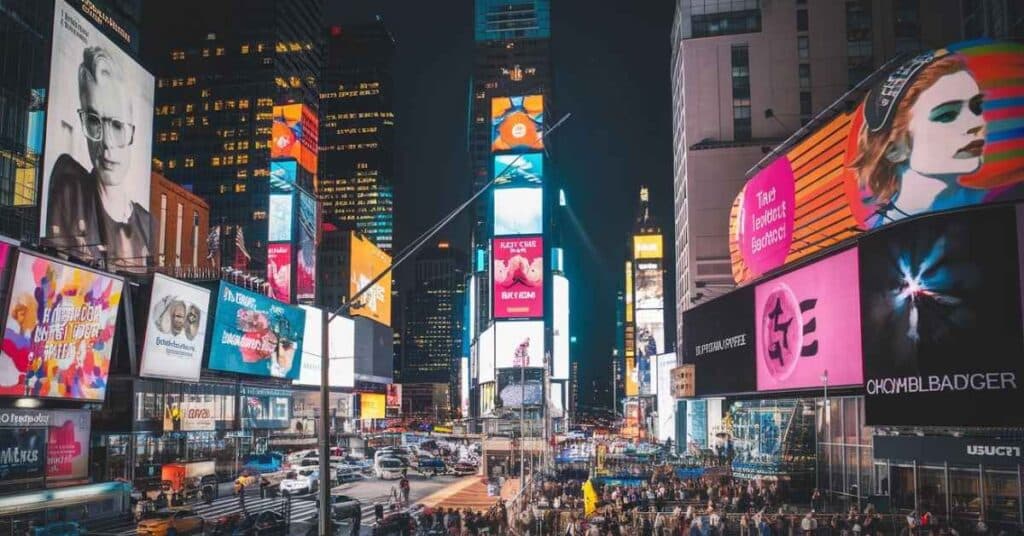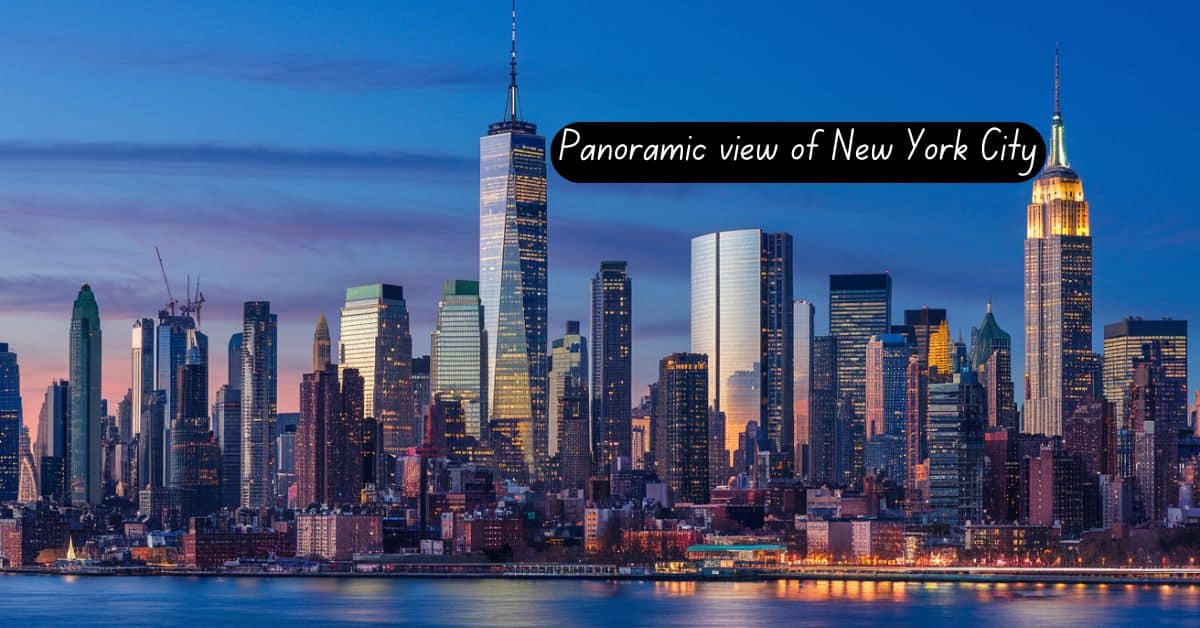New York City represents the sons of man and stands for all cultures. Definitely, no kind of development can be compared at a greater scale. Tall buildings, vast parks, and old boroughs, on an extensive scale, are things that make NYC the city of the imagination.
This guide explores the dimensions, growth, and characteristics that make the Big Apple extraordinary, offering a comprehensive look at America’s largest city.
New York City at a Glance

To understand NYC’s true scale, we must look beyond basic statistics and delve into the essential dimensions and population metrics that define its unique character.
Core Statistics
New York City covers a total area of 468.9 square miles (1,214.4 km²). This area includes land and water, of which, 302.6 square miles (783.8 km²) is land, and 166.3 square miles (430.6 km²) constitutes water.
As of 2024, NYC has a population of approximately 8.8 million residents. This immense population density reaches about 29,303 people per square mile, highlighting the city’s bustling urban environment.
Check it Out Our Article “How Big is 2 Inches? 15 Everyday Items for Comparison”
“New York is not a city, it is a world.” Henry David Thoreau
New York City in Comparison
NYC’s area and density make it distinct compared to other major cities worldwide:
| City | Population Density (per sq mile) | Total Area (sq miles) |
| New York City | 29,303 | 468.9 |
| Tokyo | 16,121 | 847.0 |
| London | 14,550 | 607.0 |
| Hong Kong | 67,433 | 427.8 |
| Chicago | 11,783 | 234.0 |
Travel Times Around New York City
For the majority of people flocking into the Big Apple, their first experience would typically be the vast network of New York City public transport. This convinces a decision in traveling as time averaged into the modes of travel train, air, road, bicycle, and walking.
By Train
The NYC subway system is a popular mode of transportation, offering quick access to key points throughout the city. Here are some average travel times between major destinations:
- Times Square to Central Park: Approximately 15-20 minutes
- Brooklyn (Williamsburg) to Manhattan (Lower East Side): About 30 minutes
- Queens (Astoria) to Manhattan (Midtown): Roughly 25-30 minutes
- Bronx (Fordham) to Manhattan (Grand Central): Around 30-35 minutes
Regional Train Travel Times
Regional trains, such as the Long Island Rail Road (LIRR) and New Jersey Transit, provide additional options for commuters. Average travel times include:
- Penn Station to Long Island City: Approximately 7 minutes
- Penn Station to Hoboken: About 15-20 minutes
- Grand Central to White Plains (Metro-North): Roughly 30-35 minutes
By Air
New York City is served by three major airports: John F. Kennedy International Airport (JFK), LaGuardia Airport (LGA), and Newark Liberty International Airport (EWR). Travel times to these airports vary based on location and time of day.
From Manhattan
- JFK: About 60-75 minutes (including check-in and security)
- LaGuardia: Approximately 30-45 minutes (including check-in and security)
- Newark: Roughly 45-60 minutes (including check-in and security)
Brooklyn
- JFK: Around 30-45 minutes
- LaGuardia: Approximately 30-60 minutes
- Newark: About 60-75 minutes
Queens
- JFK: Approximately 15-30 minutes
- LaGuardia: About 15-25 minutes
- Newark: Roughly 45-60 minutes
By Road
Driving in New York City can be challenging due to traffic congestion, especially during peak hours. Here are some average travel times between key locations, accounting for traffic variations:
- Manhattan to Brooklyn: Approximately 30-45 minutes
- Manhattan to the Bronx: About 25-40 minutes
- Manhattan to Queens: Roughly 30-50 minutes
- Brooklyn to Staten Island: Around 40-60 minutes (including the Staten Island Ferry)
By Bicycle
Biking is an increasingly popular way to navigate New York City, with many dedicated bike lanes. Average biking times for popular routes include:
- Central Park to Brooklyn Bridge: Approximately 20-30 minutes
- Lower Manhattan to Astoria (Queens): About 40-50 minutes
- Times Square to Prospect Park: Roughly 30-40 minutes
On Foot
Walking is an excellent way to explore the city at a leisurely pace. Here are typical walking times between major attractions or neighborhoods:
- Times Square to Central Park: Approximately 10-15 minutes
- Brooklyn Bridge to DUMBO: About 15-20 minutes
- The High Line to Chelsea Market: Roughly 10 minutes
- Lower Manhattan to Chinatown: Approximately 20-25 minutes
Read More About “How Long is 999 Seconds? Practical Insights and Fun Facts”
Five Boroughs of New York City

New York City is made up of five distinct boroughs, each contributing to its overall character and complexity.
Manhattan the Heart of the City
As NYC’s economic and cultural epicenter, Manhattan boasts an impressive array of landmarks and skyscrapers.
Physical Dimensions
The city of Manhattan covers an area of 22.8 square miles, or 59.1 kilometers squared. It extends 13.4 miles in length while its width maximally spans at 2.3 miles at the widest point. There are roughly 1.6 million residents but during daytime this swells up to more than 4 million with commuters included.
Notable Infrastructure
Notable infrastructure in Manhattan includes an impressive 560 million square feet of office space and 47 Fortune 500 headquarters. The skyline is defined by 284 skyscrapers that rise over 500 feet, while the borough boasts 1,700 acres of parks and 508 miles of streets, contributing to its vibrant urban landscape.
Brooklyn the Borough of Neighborhoods
Brooklyn’s vast expanse and cultural diversity make it an integral part of NYC’s identity.
Physical Characteristics
Brooklyn covers a physical area of 70.8 square miles, which translates to about 183.4 km². The borough features an extensive waterfront stretching 84 miles and is home to a population of approximately 2.6 million residents. Brooklyn is divided into 77 neighborhoods, each contributing to its unique character.
Cultural Landmarks
The borough is rich in green spaces, with over 230 parks available for recreation. Notable cultural landmarks include Prospect Park, which spans 585 acres; Brooklyn Bridge Park, covering 85 acres; the iconic Coney Island Boardwalk, measuring 2.7 miles; and the tranquil Brooklyn Botanic Garden, which occupies 52 acres.
Queens: The Largest Borough
Queens, NYC’s most expensive borough, is renowned for its cultural diversity and extensive parkland.
Key Metrics
Queens encompasses an area of 108.1 square miles, equivalent to approximately 280 km². With a population of around 2.3 million, it is one of the most diverse boroughs in New York City, boasting over 138 languages spoken by its residents.
Major Features
Queens offers ample recreational opportunities, featuring 464 parks and a sprawling shoreline that measures 121 miles. Major highlights include Flushing Meadows Corona Park, which covers 898 acres, and two major airports: John F. Kennedy International Airport and LaGuardia Airport.
Additionally, Alley Pond Park spans 655 acres, while the expansive Jamaica Bay Wildlife Refuge comprises an impressive 9,155 acres, providing vital habitats for various wildlife.
The Bronx, Gateway to the North
The Bronx balances urban life with green spaces and historic institutions, adding to NYC’s depth.
Physical Dimensions
The Bronx covers an area of 42.5 square miles, which is about 110.1 km². It is home to approximately 1.4 million residents, making it a vibrant part of New York City. Notably, parks account for 25% of the borough’s total land area, offering ample green space for recreation and relaxation.
Notable Spaces
The Bronx boasts a waterfront that pans 75 miles, enhancing its natural beauty. Among its notable green spaces is Pelham Bay Park, which covers an impressive 2,772 acres, making it the largest park in New York City.
Other significant parks include Van Cortlandt Park, with 1,146 acres, and the Bronx Zoo, which occupies 265 acres.
The New York Botanical Garden also adds to the area’s charm, covering 250 acres and showcasing a variety of plant species and beautiful landscapes.
Staten Island
Staten Island offers a unique suburban experience within NYC, with green spaces and scenic views.
Key Statistics
Staten Island encompasses an area of 58.5 square miles, equivalent to approximately 151.5 km². With a population of around 480,000 residents, it offers a suburban atmosphere within the bustling metropolis of New York City.
The borough features extensive green spaces, totaling 12,300 acres, providing residents with ample opportunities for outdoor activities.
Natural Features
Staten Island boasts 4 miles of public beaches, allowing for waterfront recreation and relaxation. Among its notable natural features is the Greenbelt, which spans 2,800 acres and includes a variety of trails and parks.
Fresh Kills Park, covering 2,200 acres, is another significant green space, while the Blue Belt includes 16 watersheds that help manage stormwater. The highest point in Staten Island is the Staten Island Range, standing at 409 feet, offering scenic views of the surrounding area.
For further informatiot “12 Things and Animals That Are 10 Feet Long”
Vertical New York
The city’s skyline and vertical growth add to its distinct scale and iconic status.
Tallest Structures
New York City is renowned for its impressive skyline, home to some of the tallest structures in the world. The One World Trade Center stands as the tallest building in the city, reaching a height of 1,776 feet..
Following closely is the Central Park Tower at 1,550 feet, and 111 West 57th Street, which rises to 1,428 feet. One Vanderbilt reaches 1,401 feet, while 30 Hudson Yards measures 1,268 feet.
Building Statistics
In terms of building statistics, New York City boasts a staggering total of 1,053,713 buildings. Among these, 284 are over 500 feet tall, while 64 exceed 800 feet. Additionally, the city is home to 28 supertall buildings, each measuring over 1,000 feet, showcasing its architectural prowess and vertical expansion.
Infrastructure of the New York City

NYC’s underground and water infrastructure provide essential services to support its population.
| Infrastructure Component | Details |
| Subway System | 850 miles of track, 472 stations |
| Annual Ridership | 1.7 billion (2023) |
| Train Cars | 6,418 operating daily |
| Water Mains | 6,800 miles |
| Sewer System | 7,500 miles |
| Daily Water Usage | Approximately 1 billion gallons |
| Reservoirs | 19 reservoirs |
| Water Tunnels | 3 major tunnels for water transport |
Subway System
The subway system of New York City is a massive interconnecting network of neighborhoods and boroughs, comprising 850 miles of track and 472 stations. Among the largest in the world, it possesses 207 miles of express tracks for speedier transfers between destinations.
By 2023, the subway has carried 1.7 billion passengers, proving to be very important in the urban transport matrix: 6,418 train cars owned and operated by the Metropolitan Transportation Authority complete the system.
Water Infrastructure
Water infrastructure of New York City is a vast system, with 6,800 miles of water mains and 7,500 miles of sewers. The city uses about 1 billion gallons of water daily, supported by 19 reservoirs and three major water tunnels, ensuring reliable access to clean water for its residents.
Continue Reading “What Are The Dimensions of a Pringles Can?”
Population Patterns in New York City

NYC’s population trends reflect waves of immigration and urban expansion.
Historical Growth
As the population grew rapidly over the ages, the city grew from 60,515 in 1800 to 696,115 by 1850. In 1900, the skyline changed with a population reaching 3,437,202 and then jumped to 7,891,957 in 1950. Thereafter, in 2000, was recorded a population of 8,008,278. By 2024, this number is expected to increase to 8,804,190.
Fun Fact: It has more than 800 languages, which means that it is among the most linguistically diverse places in the world-New York City!
Immigration Waves
New York City truly reflects the many different immigrations that it has received which helped form the cultural landscape. The 1880s saw new traditions with the coming in of Eastern Europeans. The early 1900s saw Italian communities sprouting into neighborhoods, now such a part of the city’s identity.
The 1950s saw Puerto Ricans contributing toward a enriched culture, followed by Dominican immigrants in the 1970s. The 1990s saw yet another wave of Asian immigrants adding diverse languages and cuisines. By the 2000s, Middle Eastern immigrants had shattered the city’s cultural make up even further to make it vibrant culture melting pot.
Read Further “10 Everyday Items That Are 10 Centimeters Long”
Environmental Impact of New York City

The city’s footprint is substantial, but efforts toward sustainability are growing.
Green Spaces and Initiatives
New York City boasts over 1,700 parks, collectively covering an impressive 30,000 acres. The city’s commitment to green spaces is further highlighted by its abundance of street trees, totaling around 683,000.
Additionally, there are more than 550 community gardens scattered throughout the city, providing residents with opportunities to engage in gardening and strengthen community ties.
Sustainability Metrics
In 2019, New York City recorded carbon emissions totaling 54.8 million metric tons. The city’s recycling rate stood at 17%, reflecting ongoing efforts to improve sustainability. Additionally, there are over 1,200 LEED-certified buildings throughout the city, showcasing a commitment to environmentally friendly construction.
Solar installations have also made significant strides, with capacity exceeding 200 megawatts, contributing to the city’s renewable energy goals.
Future Growth and Development in New York City
NYC’s ambitious development projects aim to meet the demands of its growing population.
Major Projects
New York City is undergoing significant transformations through various major projects aimed at enhancing urban living and sustainability. The Hudson Yards Phase 2 project, slated for completion in 2028, will add an impressive 6.2 million square feet of mixed-use space, further solidifying the area as a premier destination.
The redevelopment of Governor’s Island will cover 172 acres and feature a Climate Research Center, emphasizing the city’s commitment to environmental initiatives. Meanwhile, Sunnyside Yard plans to create 12,000 affordable homes across 180 acres, addressing the pressing need for housing in the city.
Additionally, the Brooklyn Navy Yard Expansion will introduce 5.1 million square feet of space, expected to generate around 20,000 new jobs, enhancing the local economy and employment opportunities. These projects reflect NYC’s ambition to evolve and meet the needs of its diverse population.
Check It Out “How Far is 50 Miles? 15 Common Comparisons”

NYC’s size translates into massive economic power, driving not only the city’s but the nation’s economy.
Economic Metrics
New York City’s economy is a powerhouse, reflected in its impressive economic metrics. In 2023, the city’s Gross Domestic Product (GDP) reached a staggering $1.7 trillion, showcasing its significant contribution to both the local and national economy.
The job market is robust, with approximately 4.3 million jobs available across various sectors, reinforcing NYC’s status as a major employment hub. Additionally, the city attracts around 66.6 million visitors each year, emphasizing its appeal as a global destination for tourism and business alike.
The real estate market further highlights the city’s economic strength, with a total value of approximately $1.4 trillion, underscoring the demand for property in this vibrant metropolis.
Conclusion: New York City Dimensions and Character
New York City dimensions are never physical but cultural. With miles of underground networks and the heights of magnificent skyscrapers, NYC can truly be called the nectarine for urban innovation and the embodiment of the spirit that never sleeps.
It keeps on transforming because the city has all the makings of the world’s capital to keep seducing them with its special enigma and vitality. New York City has a bright future ahead, making sure the city keeps being a beacon of personality and difference in an audibly transforming urban landscape.
Continue Reading About “15 Common Things That Are 50 mm Long/Big”

My name is Linda, and I am an experienced blogger with a passion for precision and craftsmanship. With years of expertise, I contribute to Accura Matrics, bringing a wealth of knowledge and a keen eye for detail. My insightful articles and expert tips are designed to help readers achieve excellence in their measurements and dimensions projects, offering valuable guidance in the pursuit of accurate and thoughtful design.

